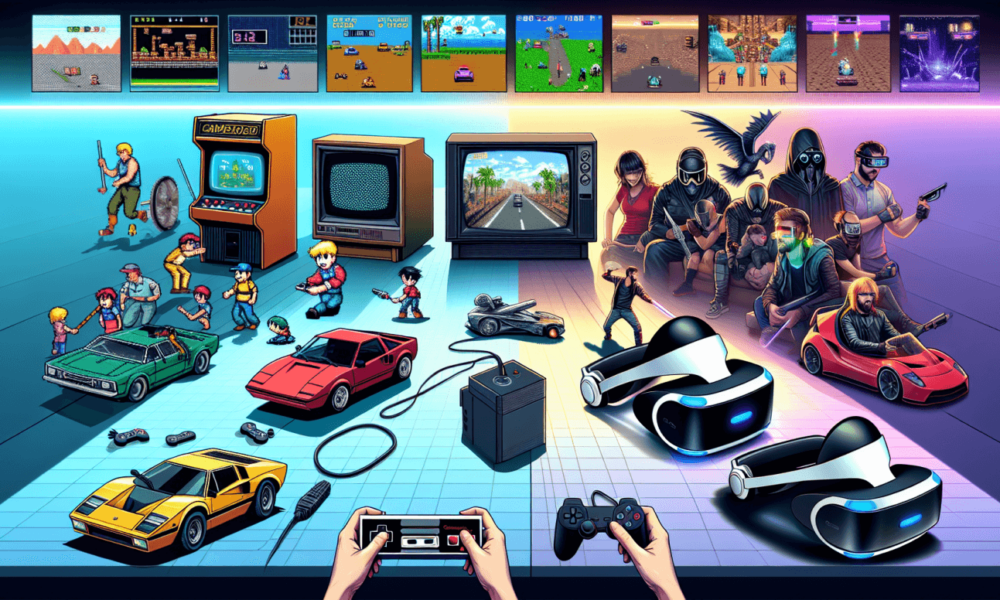
A Pixelated Beginning: The 8-Bit Era
In gaming, the visual journey began humbly with 8-bit graphics. These early games, like the iconic Pac-Man and Space Invaders, used a limited palette of colors and basic pixel blocks to create what was then a revolutionary visual experience. Each sprite and background was a mosaic of pixels, where creativity flourished within close constraints.

16-Bit and the Rise of Detail
The leap to 16-bit graphics in consoles like the Super Nintendo Entertainment System marked a significant shift. Games like Super Mario World and The Legend of Zelda: A Link to the Past offered richer colors and more detailed environments. This era was a sweet spot for many, where art and technology melded to create memorable, stylistic games.
It wasn’t just about the increase in color palettes or sprite sizes; it was how stories could be told with more depth and character expressions could be more nuanced. Iconic titles like Street Fighter II and Chrono Trigger showcased detailed animations and backgrounds, bringing game worlds to life. This period in gaming history set the stage for narrative-driven and visually rich titles, forming a foundational pillar in the evolution of video game aesthetics.
The 3D Revolution: A New Dimension in Gaming
The introduction of 3D graphics in consoles with Sony’s PlayStation and Nintendo’s N64 was nothing short of revolutionary, transforming game design and graphics. Titles like Super Mario 64 and Final Fantasy VII weren’t just games; they were gateways to immersive worlds, demonstrating the incredible potential of 3D graphics. This era wasn’t just about polygons and textures; it was about exploring gaming spaces in entirely new ways, bringing players closer to the action and making game environments more realistic and engaging.
This transformative period in console gaming had its parallel in the world of online entertainment. For example, online slots have transitioned from basic, three-reel designs to intricate, thematic experiences. Games like Starburst, Gonzo’s Quest, and many more offer vivid visuals and engaging themes, ranging from intergalactic space to futuristic landscapes. These platforms showcase how online entertainment can be visually stunning and engaging, blending artistic expression with digital innovation.
Realism and Beyond: The HD Era
The jump to high definition in gaming brought about titles like The Elder Scrolls V: Skyrim and Uncharted, which boasted lifelike textures and environments. This era’s hallmark was its push towards photorealism, offering players worlds that were increasingly indistinguishable from reality.
Enhanced lighting effects, dynamic weather systems, and detailed character models became the norm. Games like Crysis were not just played; they were experienced, pushing the boundaries of what was technically possible in digital environments. This era bridged the gap between fantasy and reality, making virtual worlds a place to get lost in.
The Indie Influence: Aesthetic Diversity
The rise of indie games in the late 2000s, like Minecraft and Limbo, brought a new diversity to gaming graphics. These games didn’t need the latest technology to shine; instead, they leveraged unique artistic styles to stand out, reminding us that, in gaming, creativity knows no bounds.
Indie developers used artistic expression to convey themes and emotions, often with limited resources. Games like Braid and Fez combined innovative gameplay with distinctive visual styles. This era of gaming proved that great visual storytelling wasn’t just the domain of blockbuster titles but could be achieved by any game with a vision and a passionate team behind it.
Virtual Reality: The New Frontier

Virtual Reality (VR) represents the latest frontier in gaming graphics. Titles like Half-Life: Alyx demonstrate how VR can create a level of immersion that is impossible with traditional gaming. This technology is not just changing how we play games; it’s revolutionizing how we experience them.
With VR, players are no longer just observers but active participants in game worlds. The tactile feedback, 360-degree view, and motion tracking make every action feel real. Games like Beat Saber and VRChat show the versatile potential of VR, from rhythm-based gameplay to social interactions, opening a realm where the virtual and real blur indistinguishably.
A Pixelated Path to the Future
The evolution of gaming graphics is a testament to human creativity and technological advancement. From the charming simplicity of 8-bit graphics to the immersive worlds of VR, each step has expanded our understanding of what games can be. One thing is certain as we look to the future: the pixels will continue to push boundaries, taking us to worlds beyond our imagination.

Post a Comment